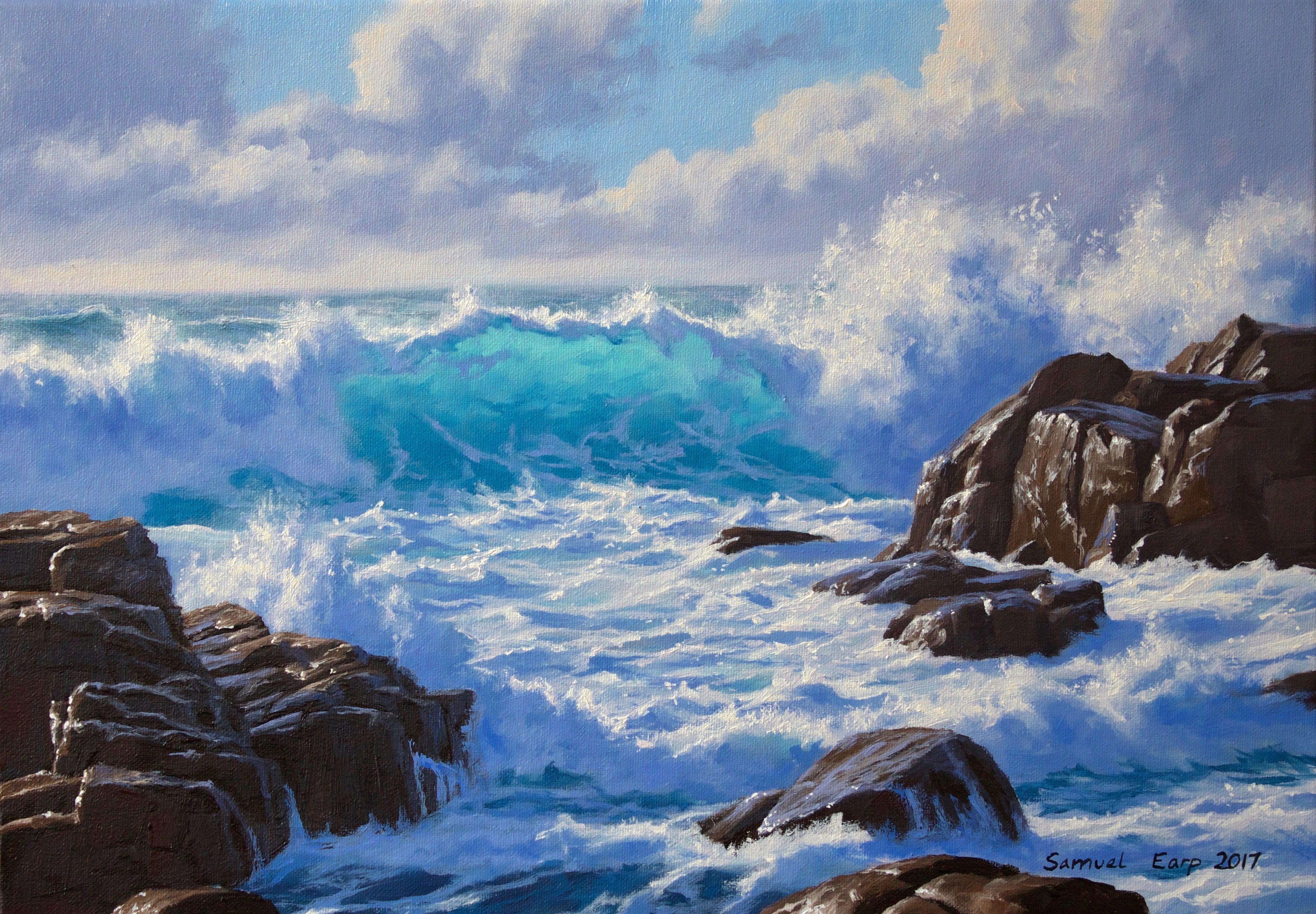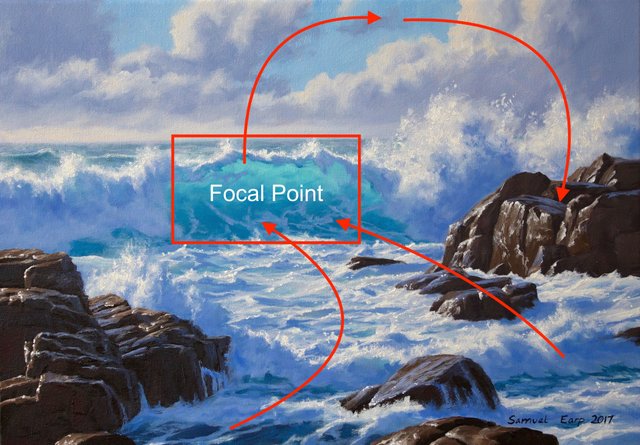Painting a Dramatic Seascape - Part 1 - Blocking in the Painting
Hello Steemers
I love to paint the sea, in fact it's one of my favourite things to paint!
Just recently I finished painting this seascape called 'Wild Atlantic Ocean' and in this blog post I will show you my painting process of how I created this art work.
I am currently making a video on how to paint this which I will upload to my YouTube and DTube channels in which this blog will accompany the video so stay tuned for that.

'Wild Atlantic Ocean', 40cm x 50cm, oil on canvas.
CREATING THE COMPOSITION
This painting began with me taking photos from a place called Port Soif on the island of Guernsey, UK. The sea was rough and there was lots of light and atmosphere.
Port Soif is a great place for getting photo reference for seascapes, especially in the evening as the light is behinf the waves which means you get contrast between the shadows of the breaking waves but sharp highlights in the wave crests and white water. These are all ingredients for epic seascape paintings!
This is one of the photos I used to create this painting, feel free to copy or use it.
After I get my photo reference I sit down with my sketch book and draw some small thumbnails sketches which results in a final sketch which I refer to when painting my seascape.
The composition I have created for this seascape is an 'S' composition, where the breaking wave is the focal point and the direction of the rocks in the foreground leads the eye towards the wave. The direction of the clouds then leads the eye across to the right to form an 'S' shape before leading the eye back down towards the rocks on the right.
The other rocks in the foreground also point in the direction of the breaking wave.

MY COLOUR PALETTE
I am using Langridge Handmade Oils and I'm using the following colours:
Titanium white
Yellow oxide
Burnt Sienna
Burnt Umber
Cadmium red light
Quinacridone magenta
Ultramarine blue
Cobalt blue
Cobalt teal
Pthalo green
BRUSHES USED
Flat bristle brushes, No.6 and No 2.
Ivory daggers, 3/8" and 1/4"
Synthetic rounds
BLOCKING IN THE PAINTING

I begin my painting by sketching out the scene with titanium white mixed with quinacridone magenta and liquin which is a medium that thins the paint and speeds up the drying.
You'll notice I am not painting on a white canvas, instead I previously applied a layer of burnt sienna which gives vibrancy to the painting as it comes through the paint layers.

I always begin by painting the sky as this is the furthest away, I mix the colours in the sky with cobalt blue, cobalt teal, a little ultramarine blue and titanium white.
For the clouds I paint the highlights with pure titanium white, knowing that the shadow colours will mix in and that I'll be returning to it later on in the painting.
For the cloud shadows I mix ultramarine blue with burnt umber which knocks out the saturation of the blue. I then add a little quinacridone magenta to tip the mixture on the violet side and then add titanium white to lighten the tone.
I paint the horizon of the sea taking care to desaturate my blue mix so it doesn't come forward in the painting.
Whenever you paint a seascape or indeed a landscape go for either a high horizon or a low horizon, never in the middle of the painting as it is distracting to the composition.

I use pure titanium white to roughly mark the areas where the highlights of the waves and white water will go, again I am not worried it's come straight from the tube as it'll soon mix with the other shadow colours I an going to use.
I paint the translucency of the wave by mixing cobalt teal, pthalo green and titanium white. As I paint the main body of the wave I start introducing cobalt blue and ultramarine blue. I also use the colours to roughly mark out the shadows in the foreground white water.

I paint the shadows of the breaking waves by mixing ultramarine, cobalt blue and titanium white.
I use my trio of blues for the sea at the bottom of the painting and I also add a little quinacridone magenta and pthalo green to darken the tone.
I block in the shadows of the rocks by mixing burnt umber with ultramarine blue which creates a near black.

To complete the blocking in stage I paint the areas of the rocks that are in light using a combination of burnt umber, burnt sienna, yellow oxide and titanium white. I form the basic shapes with an ivory dagger brush.
With the blocking in stage complete I allow the painting to dry before beginning the next stage of the painting.
Stay tuned for Part 2 of this painting tutorial coming soon........
I hope you enjoyed this blog post and if you found this blog post interesting and helpful and you like what I do, any tips to help support my art career would be greatly appreciated.
Bitcoin: 15gYGgeLeBdeSvZmYoZ5GwrabWNjvXi5hL
Litecoin: LYzNsMfSHjSPn5V6gK6jTJB74L6ydbA3rM
Dash: XmHqFwzmyhax3zm2Q3hVhqAYfMZ2AqaZ3f
Check out my website for more painting demos and my art: samuelearp.com
Subscribe to my mailing list for news, new paintings and art tips and receive a FREE DIGITAL ART PRINT DOWNLOAD of one of my seascape paintings suitable for printing an image of any size: https://www.samuelearp.com/subscribe/
Painting dramatic seascape is my next project but too scary to even think about it. ;)
Yours is beautiful, and that wave is what I have in mind. Looks so natural! Congratulations!
Thanks @realmeandi, don't be scared, give it a go. I'm currently in the making a video for my YouTube channel on how to paint this seascape which I hope to upload in the next week.
My YouTube channel is: Samuel Earp Artist
Thank you.
Great idea as I was actually thinking of some YT tutorial videos. ;)
Superb shades of blue. Great movement and translucency, @samuel-earp-art :)
Thanks @nehab :)
welcome!!